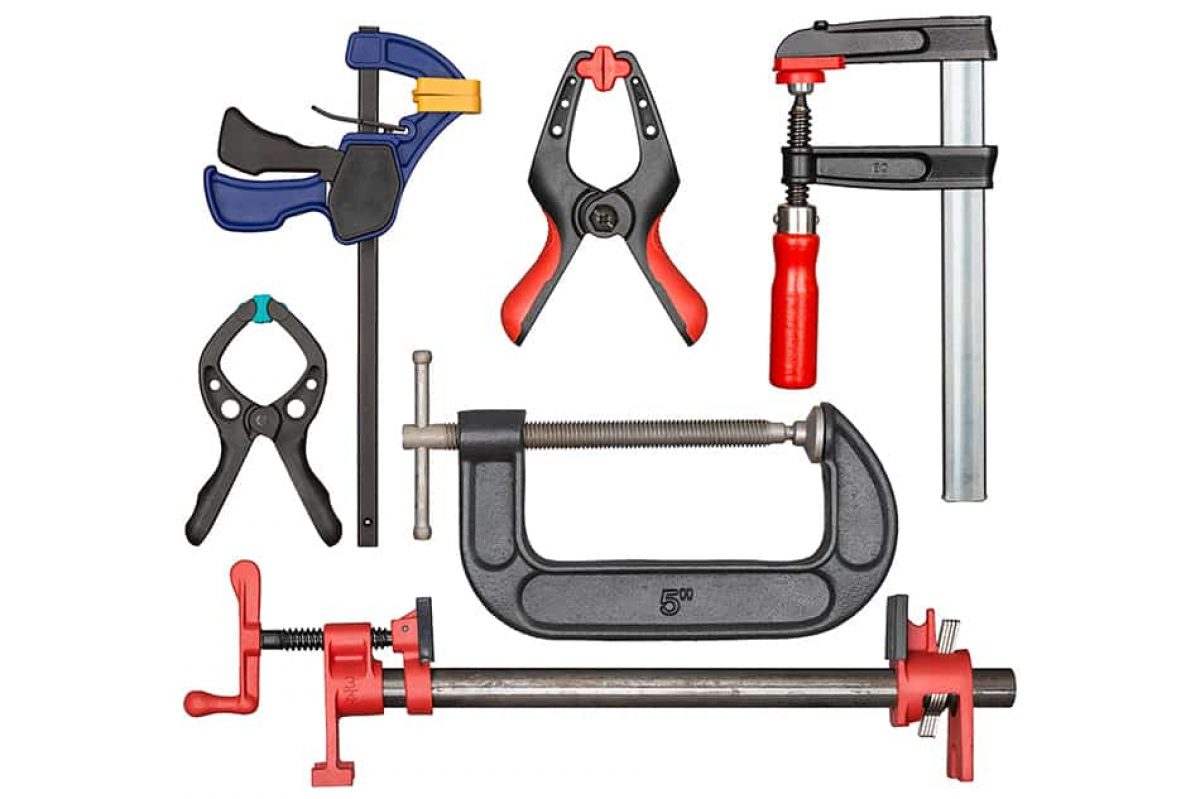Clamp tools are essential devices used to temporarily hold or fasten objects together. They provide a pressing force to secure two or more pieces in place during assembly, allowing the user to manipulate or work on the project. Clamping tools come in a wide variety of types and sizes for different applications.
Some of the most common categories of clamping tools include bar clamps, handscrew clamps, spring clamps, toolmaker’s clamps, vise grips, sash clamps, corner clamps, and gluing clamps. They use leverage, friction, or compression to apply force and grip items tightly. The amount of force applied can often be adjusted as needed.
Clamping tools are commonly used for woodworking, metalworking, automotive repair, construction, and other hands-on trades. They enable the user to join components, hold them steady for tasks like cutting or drilling, apply adhesive, and align parts during assembly. Quality clamps allow the user to work efficiently and achieve accurate results. With the right clamps, many jobs become much easier.
Table of Contents
Bar Clamp tool
Bar clamps are a versatile type of clamp used in woodworking and other DIY projects. They consist of an adjustable bar with movable jaws on each end that can be tightened to apply even clamping pressure.
Description
Bar clamps typically have a long bar made of steel or aluminum with a sliding jaw on one end and a fixed jaw on the other. The sliding jaw can be positioned along the bar and tightened in place with a screw mechanism or quick-release lever. The length of the bar determines the maximum opening capacity, with lengths ranging from 12 inches up to 8 feet or more. Most have a throat depth around 3 inches but deeper reach models are available. The jaws are often padded to prevent marring the workpiece. Bar clamps are operated by hand.
Uses
Bar clamps excel at clamping large, flat workpieces in applications like:
- Gluing boards together to make tabletops, doors, or panels
- Holding cabinets and furniture parts in alignment while assembling
- Applying pressure while gluing joints and laminations
- Clamping forms and molds together
Their adjustable capacity and ability to exert substantial pressure makes bar clamps one of the most useful and versatile workshop clamps.
Pros
- Available in a wide range of lengths and throat depths
- Sliding jaw allows capacity to be easily adjusted
- Apply strong, even pressure across their length
- Deeper reach models can clamp thicker workpieces
- Padded jaws help prevent marring
- Relatively low cost clamp for their versatility
Cons
- Limited to clamping flat surfaces
- Require two hands to position and tighten
- Large models can be bulky and difficult to position
- Lower clamping force than other types like C-clamps
Types
There are three main types of bar clamps:
- C-Clamps: Have a C-shaped frame with a fixed jaw on one end and sliding jaw tightened by a screw mechanism on the other. Typically used for smaller jobs.
- Bar Clamps: As described above, with a long straight bar and sliding/fixed jaws. Ideal for most workshop clamping tasks.
- Pipe Clamps: Use steel black pipe as the bar which allows for very long lengths. Typically used for large glue-ups. The pipe slides into a head with the clamping mechanism on one end and a fixed jaw on the other.
Overall, bar clamps are an essential clamping tool useful for a wide variety of DIY, woodworking, metalworking, and home repair jobs where strong, adjustable clamping pressure is needed. Their versatility and capacity makes them one of the most useful clamps to have in any workshop.
Handscrew Clamp tool
Handscrew clamps, also known as bar clamps or screw clamps, are versatile tools used to hold wood pieces together for gluing, assembling, or machining. They consist of two wooden or metal jaws connected by an adjustable screw mechanism that allows the user to open and close the jaws to clamp materials of various thicknesses.
Handscrew clamps are operated by turning the handle on the end of the threaded rod to drive the jaws together. The clamping pressure applied can be finely adjusted, making them useful for delicate woodworking operations. The large jaws and deep throat depth also allow handscrew clamps to clamp uneven or large workpieces.
Wood Handscrews
- Made of hardwood like beech or maple. Durable but can mar soft wood.
- Lightweight, good for delicate projects.
- Jaws can be padded to prevent marring.
- Limited clamping force compared to metal.
Metal Handscrews
- Very sturdy with high clamping force. Good for heavy duty jobs.
- Steel jaws may damage workpiece.
- Heavier than wood but won’t warp.
- Can rust if not maintained.
Handscrew clamps are versatile tools that can be used to hold gluing joints, act as portable vises, clamp irregular shapes, or hold assemblies together for machining. They provide a good balance of adjustability, clamping force, weight and cost. The main downside is they take more time to adjust than other clamps.
Spring Clamp tool
Spring clamps, also known as one-handed bar clamps, are a versatile type of clamping tool. As the name suggests, they utilize a spring mechanism to provide quick, one-handed clamping pressure.
Spring clamps consist of two jaws attached by a steel spring. One jaw typically remains stationary, while the other moves along the bar and compresses the spring to provide clamping force. This allows them to be easily opened and closed with one hand. Most have a trigger-style handle and built-in teeth or a non-slip pad to firmly grip the workpiece.
These clamps are ideal for quick, temporary bonding or clamping tasks. They can be used to glue small objects or hold pieces in place for nailing, screwing, drilling and other operations. Their speed and one-handed operation make them convenient for tasks where you need to work quickly.
Some key advantages of spring clamps include:
- One-handed operation – leaves one hand free to position pieces
- Fast to open and close
- Lightweight and portable
- Inexpensive compared to other clamps
- Available in various jaw sizes and throat depths
Potential disadvantages include:
- Limited clamping force and strength compared to bar clamps
- Can damage soft materials like wood due to small jaw contact area
- Not suitable for precision work or keeping objects square
- Jaws may bend or distort thin materials
There are a few main types of spring clamps:
- Standard – Basic fixed-length clamps with no adjustments
- Locking – Ratcheting mechanism keeps pressure locked on
- Long Reach – Extra long jaws for reaching into tight spaces
- Wide Jaw – Larger jaw surface to prevent marring
Overall, spring clamps are a versatile, affordable option suitable for everyday home and workshop tasks like gluing, holding, assembling and more. Their speed and one-handed convenience make them a useful addition to any tool collection.
Toolmaker’s Clamp tool
Toolmaker’s clamps, also known as C-clamps, are versatile clamps used for woodworking, metalworking, automotive work, and other projects. They get their name from their heavy use in toolmaking and machine shops.
Description
Toolmaker’s clamps consist of a C-shaped frame with a threaded screw that advances towards the frame when turned. The screw applies downward clamping pressure as it moves closer to the frame. The frame and screw are typically made of steel, while the clamping pads are wood, plastic, rubber, aluminum, or steel.
These clamps come in a wide range of sizes, with throat depths from 1 inch up to 8 inches or more. The smaller sizes are best for precision work, while larger sizes provide more clamping power. Most have a swiveling pad on the screw end to adapt to uneven surfaces. Higher end models may have ball joints instead of swiveling pads.
Uses
Toolmaker’s clamps are very versatile clamps suitable for:
- Clamping parts together for gluing, welding, machining, etc. Their adjustable pressure allows clamping without damage.
- Acting as a third hand to hold items in place hands-free. Their rigid frames can support weight and resist movement.
- Applying localized pressure, such as clamping materials for cutting or bending.
- Positioning workpieces at angles and heights. The frame provides a sturdy base of support.
They are commonly used for woodworking, metal fabrication, automotive repair, model building, arts and crafts, and other applications requiring a rigid, sturdy clamp. Their C-shape frames can reach into tight spaces and corners.
Pros
- Very versatile and usable for many applications
- Rigid frames provide strength and support
- Adjustable clamping pressure
- Frame design reaches into tight spaces
- Durable construction for heavy duty use
- Wide range of sizes for light or heavy clamping needs
Cons
- More expensive than other clamps like spring clamps
- Bulky shape limits portability
- Limited to clamping within the frame’s throat depth
- Exerts focused pressure on a small area
Vise Grips
Vise grips are adjustable pliers that can clamp onto a variety of materials and objects. They are versatile tools that can serve as a substitute for regular pliers, clamps, wrenches, and other tools.
Description
Vise grips consist of two adjustable jaws operated by a scissor action handle. The more the handles are compressed, the tighter the jaws clamp down. Most vise grips have serrated teeth on the jaws to help them firmly grip objects. The jaws can lock in place at various widths to accommodate different sizes of material. Standard vise grip sizes range from 4 inches to 10 inches.
Uses
- Clamping and holding irregular shaped objects in place for tasks like gluing, soldering, drilling, cutting, etc.
- Gripping nuts, bolts, pipes, and rods to turn them. The locking jaws allow you to firmly grip the object while applying torque.
- Pulling nails, staples, and small spikes. The serrated jaws can tightly grip small fasteners for removal.
- Crimping and bending metal, wire, and plastic tubing. Vise grips can lock onto soft materials and bend them into shape.
Pros
- Very versatile and can substitute for many other tools
- Self-locking jaws keep a tight grip without needing to hold the handles
- Jaws can grip in many positions based on the shape of the object
- Durable construction for heavy duty use
Cons
- Not as efficient as purpose-built tools for specific jobs
- Can damage soft materials like wood by digging into the surface
- Limited clamping depth compared to bar clamps or vise jaws
- Jaw width not adjustable on some basic models
Types
- Standard vise grips with general purpose serrated jaws
- Long nose or needlenose vise grips for reaching into tight spaces
- Specialty pliers like wire crimpers, bolt cutters, pipe wrench jaws
- Vise grips with smooth jaws to avoid marring soft surfaces
- Miniature vise grips for precision work
- Locking C-clamps with vise grip style adjustable jaws
Vise grips are versatile clamping pliers that can assist with holding, gripping, turning, bending and crimping tasks. Their adjustable locking jaws allow them to tackle many jobs where a custom grip or clamp is needed. They are a handy tool to have for metalworking, automotive work, plumbing, electrical, DIY and more.
Sash Clamps
Sash clamps, also known as bar clamps, are a longer version of bar clamps. They consist of two adjustable jaws connected by a bar. The bar can range from 3 feet to 8 feet in length.
Description
Sash clamps feature a fixed jaw on one end and an adjustable jaw on the other. The adjustable jaw slides along the bar and is tightened into place with a threaded mechanism. The longer bar provides more clamping capacity and allows sash clamps to apply even pressure across larger projects. The bars are typically made of steel or aluminum.
Uses
Sash clamps excel at clamping large panels and wide assemblies where more clamping pressure is needed across a greater surface area. Common uses include:
- Clamping large tabletops or doors during glue-ups
- Applying even pressure across large cabinet carcasses or frames
- Holding curved or irregular shapes in place as glue dries
Their length also makes them useful for clamping projects vertically rather than just horizontally.
Pros
- Evenly distributes clamping pressure across wide spans
- Long reach allows vertical or angled clamping
- Bars remain straight even under heavy loads
- Relatively affordable compared to other long clamps
Cons
- Bulkier and heavier than smaller clamps
- Can flex if not sufficiently rigid for task
- Limited versatility compared to adjustable clamps
- Require more storage space
Sash clamps are ideal for woodworkers who regularly work with larger panels and assemblies. Their extended length and capacity make them a versatile addition to any workshop.
Corner Clamps
Corner clamps are designed to clamp perpendicular workpieces and hold them at a 90 degree angle. They are ideal for assembling frames, boxes, and other projects with corners.
Description
Corner clamps consist of two adjustable clamping bars connected by an adjustable corner piece. The corner piece allows you to set the clamp at the desired angle, usually 90 degrees. The bars can slide to accommodate different size workpieces. Many corner clamps have padded faces to prevent marring the wood.
Uses
- Holding picture frames, boxes, drawers, and other assemblies at 90 degree corners
- Clamping two boards perpendicular to each other for joining
- Holding small parts for gluing and assembly
Pros
- Holds work at 90 degrees during glue up
- Adjustable to fit different size workpieces
- Padded faces prevent marring
- Strong clamping pressure
- Allows hands free operation during glue up
Cons
- Limited to right angle clamping
- Typically only for small to medium size workpieces
- More expensive than spring clamps
Types
There are a few main types of corner clamps:
- Fixed: These have set 90 degree angles and the clamps are fixed in relation to the corner piece. Less adjustable but simple to use.
- Adjustable: These allow you to slide the clamping bars and adjust the angle of the corner piece. More versatile but more moving parts.
- One-handed: These operate the clamping mechanism with one hand so you can position and tighten with one hand. Convenient but less clamping pressure.
- Quick-grip: These use a quick release mechanism to engage the clamp quickly without turning a screw. Faster operation but lower maximum clamping force.
So in summary, corner clamps are great for holding assemblies at 90 degrees and freeing up your hands for glue-ups. Look for adjustable models if you need flexibility or one-handed operation for convenience.
Gluing Clamps
Gluing clamps, also known as bar clamps, are a versatile type of clamp used for woodworking and other projects that require gluing. They consist of two adjustable bars connected by a mechanism that allows you to apply even clamping pressure across the length of the bar.
Description
Gluing clamps typically have a steel or aluminum bar with a sliding adjustable head on one end and an adjustable foot on the other. The head and foot allow you to open and close the gap between the bars evenly. Most models have a trigger mechanism to quickly open and close the clamp, as well as an acme threaded rod to finely adjust the pressure. The bars usually have anti-marring pads to protect the workpiece. Gluing clamps come in various lengths, typically from 6 inches up to 60 inches.
Uses
Gluing clamps are ideal for clamping large panels or assemblies where pressure needs to be applied across a wide area. They are commonly used for gluing panels for furniture, doors, cabinetry, and other woodworking. The bars distribute clamping force evenly to help ensure good adhesion across the entire joint. Gluing clamps can also be used as spreader clamps to hold parts in alignment during assembly.
Pros
- Evenly distribute pressure across a large area
- Available in a wide range of sizes
- Relatively inexpensive
- Provide good clamping force for most applications
- Quick release mechanism allows fast clamping
Cons
- Limited to length of the bar
- Can mar soft woods if not padded
- Not as rigid as solid bar clamps
- May not provide enough pressure for some situations
Types
- Aluminum bar clamps are lightweight but can bend under heavy pressure
- Steel bar clamps are heavier but less prone to bending
- One-handed clamps allow quick one-handed operation
- Extendable bar clamps can connect multiple bars together
- Corner clamps have angled heads for clamping frames
- Deep reach clamps have an extended throat depth
Gluing clamps are a workshop staple thanks to their versatility, power, and ability to clamp over a wide area. They are a must-have for larger woodworking projects. With a variety of sizes and designs available, gluing clamps can handle most any gluing task.
Conclusion
Having a variety of clamping tools available is crucial for any woodworking or DIY project. Clamps allow you to hold pieces steady for gluing, assembling, machining, and finishing. The right clamps make these tasks easier and help ensure you get tight joints and accurate results.
The different types of clamps each serve unique purposes. Bar clamps excel at clamping large panels or long pieces. Handscrew clamps provide tremendous clamping pressure through their threaded mechanisms. Spring clamps are ideal for quick, temporary clamping needs. Toolmaker’s clamps offer precise control for detailed work. Vise grips substitute for clamps in a pinch. Sash clamps extend your reach. And corner clamps pull tight joints at right angles.
Having an assortment gives you the flexibility to choose the best clamp for each application. Investing in quality clamps from reputable brands will pay dividends over time. Take time to learn how to properly use each type of clamp. With practice, you’ll gain skill in getting the right clamping pressure and alignment. Mastering clamping techniques will lead to professional-looking results.
The right clamps make all the difference in successfully completing woodworking and DIY projects. Build up your clamp collection so you always have the perfect clamp ready for any task.



